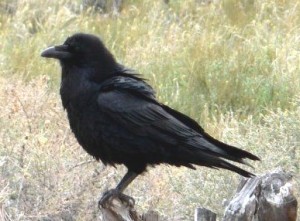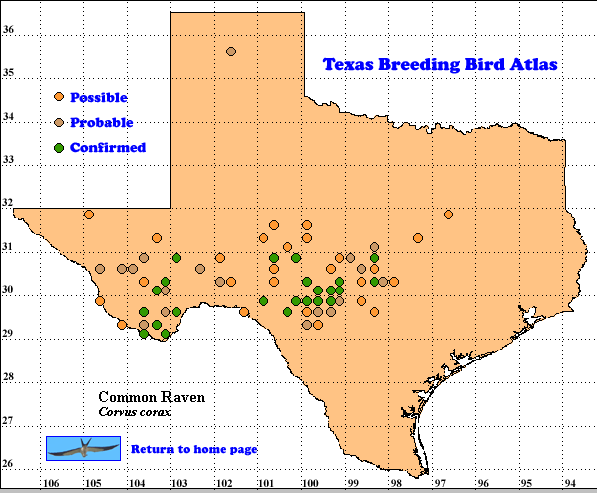Common Raven is one of the largest passerine birds in the world; some individuals exceed 1.5 kg (3.3 lbs) in weight. At present all populations in the Old and New Worlds are considered one species although mitochondrial DNA sequencing shows a considerable difference between the population in western North America and the eastern North American and Old World populations (Boarman and Heinrich 1999).
DISTRIBUTION. During the 1987-1992 field work for the TBBA project researchers found Common Ravens breeding in the Trans Pecos and Edwards Plateau regions (see map in Lockwood and Freeman [2004]) with a confirmed breeding observation in the northern Panhandle. North American Breeding Bird Survey data from 25 routes of 40 km (25 mi) on which this raven was detected produced a map similar to the TBBA map. The highest relative abundance was in the southeastern Trans Pecos and the central Edwards Plateau (1-3 ravens detected per route) with <1 per route in the rest of the area (Sauer et al. 2005).
Elsewhere in North and Middle America this species is resident from Alaska across Canada to the Atlantic Ocean and south in the western United States and Mexico to the Isthmus of Tehuantepec with additional populations in the highlands south to Nicaragua. East of the Great Plains Common Ravens breed in the United States across the northern parts of the Great Lakes states, New York and New England and south in the Appalachians to Georgia (Howell and Webb 1995, Boarman and Heinrich 1998).
SEASONAL OCCURRENCE. Lockwood and Freeman (2004) describe Common Raven as a resident. Breeding occurs from mid-April to late June with egg dates from April 25 to June 1 (Oberholser 1974).
BREEDING HABITAT. In Texas Common Ravens breed from 300 to 2400 m (1000- 8000 ft) in mountains and canyons and on cliffs (Oberholser 1974). In Colorado where breeding habitats were quantified, about half of nesting occurred in coniferous habitats, ranging from pinyon-juniper to spruce-fir. Cliffs, deciduous woodlands, shrub-lands and grasslands each provided around 10% of the total (Winn 1998).
In Arizona, the largest number of breeding records comes from Sonoran desert scrub (19%) followed by pinyon-juniper woodland (18%), sagebrush (7%) and Great Basin grassland with scattered pinyon and juniper (6%). The remaining records come from 32 habitat types with no habitat contributing more than 5% of the total. This broad range extends from cliffs and canyons to rural, agricultural and urban areas (Wise-Gervais 2005).
The large nest, often built atop a previous one, is constructed of tree branches, sticks, twigs and vines and is deeply hollowed.. It is thickly lined with animal hair, moss, grass and bark shreds. The outside diameter is 0.6 to 1.2 m (2-4 ft), inside diameter 30 cm (1 ft), and cup depth is 15 cm (6 in). The area around the nest is often white-washed with droppings (Harrison 1979).
The female usually lays 5-6 (range 4-7) greenish eggs (see Harrison [1979] for photo of markings). The female does most of the incubation, only at night until the clutch is complete and then also during the day for 20-25 days. The young birds leave the nest 4-7 weeks after hatching. Only one brood is raised per year (Boarman and Heinrich 1999).
STATUS. Lockwood and Freeman ( 2004) consider Common Raven an uncommon to common resident in the Trans Pecos and Edwards Plateau regions of Texas. BBS data produce a 95% confidence interval (There is a 95% chance that the actual population trend will be between these two numbers.) for Texas of -3.2 to +5.5% population change per year for the period 1966-2004. Results from 1710 routes across the United States and Canada provide a statistically significant +2.5% change per year for the sane period (Sauer et al. 2005). These figures are encouraging for the future of Common Raven in Texas.
Text by Robert C. Tweit (2006)
Literature cited.
Boarman, W. I. and B. Heinrich. 1999. Common Raven (Corvus corax). In The birds of North America, No. 476 (A. Poole and F. Gill, eds.). The Birds of North America, Inc., Philadelphia, PA.
Harrison, H. H. 1979. A field guide to western birds’ nests. Houghton Mifflin, Boston, MA.
Howell, S. N. G. and S. Webb. 1995. A guide to the birds of Mexico and northern Central America. Oxford University Press, New York.
Lockwood, M. W. and B. Freeman. 2004. The TOS handbook of Texas birds. Texas A&M University Press, College Station.
Oberholser, H. C. 1974. The bird life of Texas. University of Texas Press, Austin.
Sauer, J. R., J. E. Hines, and J. Fallon. 2005. The North American Breeding Bird Survey, results and analysis 1966-2004. Version 2005.1. USGS Patuxent Wildlife Research Center, Laurel MD (Web site, http://www.mbr-pwrc.usgs.gov/bbs).
Winn, R. A. 1998. Common Raven (Corvus corax). In Colorado breeding bird atlas, pp. 330-331 (H. E. Kingery, ed.). Colorado Bird Atlas Partnership, Denver.
Wise-Gervais, C. 2005. Common Raven (Corvus corax) In Arizona breeding bird atlas.p p. 366-367 (T. E. Corman and C. Wise-Gervais, eds.). University of New Mexico Press, Albuquerque.

